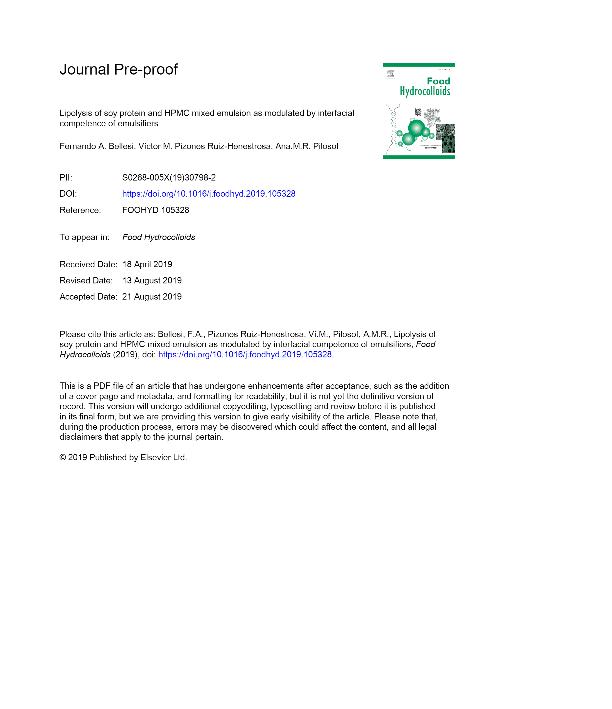Mostrar el registro sencillo del ítem
dc.contributor.author
Bellesi, Fernando Alberto

dc.contributor.author
Pizones Ruiz Henestrosa, Víctor Manuel

dc.contributor.author
Pilosof, Ana Maria Renata

dc.date.available
2021-09-02T01:18:50Z
dc.date.issued
2019-08
dc.identifier.citation
Bellesi, Fernando Alberto; Pizones Ruiz Henestrosa, Víctor Manuel; Pilosof, Ana Maria Renata; Lipolysis of soy protein and HPMC mixed emulsion as modulated by interfacial competence of emulsifiers; Elsevier; Food Hydrocolloids; 99; 105328; 8-2019; 1-28
dc.identifier.issn
0268-005X
dc.identifier.uri
http://hdl.handle.net/11336/139496
dc.description.abstract
As the lipolysis is an interfacial process, the oil/water interfacial layer that stabilizes lipid emulsions has gained increasing attention as potential modulator of human lipids digestion. The control of the characteristics of interfacial layers would allow the design of specific emulsions to control lipid delivery, satiety or reduce lipids digestion. The aim of this study was to study the performance of HPMC-SPI emulsions under in vitro physiological conditions in order to determine the impact of the interfacial composition in the lipolysis process. The prevalence at the interface of one of the emulsifiers may affect the composition of the interfacial films and, hence the behavior of emulsion during the gastrointestinal tract affecting the lipolysis degree. A static in vitro digestion system was used to mimic the gastrointestinal conditions and free fatty acids release was determined as related with the droplet size distribution of oil and with the interfacial elastic modulus. Under competitive conditions the HPMC predominated at the surface of oil droplets, controlling the droplet size distributions and surface area and hence the degree of lipolysis. A linear relationship was found between the initial interfacial area of each emulsion and the degree of lipolysis. The structure of the interfacial layer had a clear impact in the degree of lipids digestion.
dc.format
application/pdf
dc.language.iso
eng
dc.publisher
Elsevier

dc.rights
info:eu-repo/semantics/openAccess
dc.rights.uri
https://creativecommons.org/licenses/by-nc-sa/2.5/ar/
dc.subject
LIPOLYSIS
dc.subject
INTERFACE
dc.subject
SOY PROTEIN
dc.subject
HYDROXYPROPYLMETHYLCELLULOSE
dc.subject.classification
Alimentos y Bebidas

dc.subject.classification
Otras Ingenierías y Tecnologías

dc.subject.classification
INGENIERÍAS Y TECNOLOGÍAS

dc.title
Lipolysis of soy protein and HPMC mixed emulsion as modulated by interfacial competence of emulsifiers
dc.type
info:eu-repo/semantics/article
dc.type
info:ar-repo/semantics/artículo
dc.type
info:eu-repo/semantics/publishedVersion
dc.date.updated
2020-11-25T17:58:38Z
dc.journal.volume
99
dc.journal.number
105328
dc.journal.pagination
1-28
dc.journal.pais
Países Bajos

dc.journal.ciudad
Amsterdam
dc.description.fil
Fil: Bellesi, Fernando Alberto. Universidad de Buenos Aires. Facultad de Ciencias Exactas y Naturales. Departamento de Industrias. Instituto de Tecnología de Alimentos y Procesos Quimicos. Consejo Nacional de Investigaciones Científicas y Técnicas. Oficina de Coordinación Administrativa Ciudad Universitaria. Instituto de Tecnología de Alimentos y Procesos Quimicos.; Argentina
dc.description.fil
Fil: Pizones Ruiz Henestrosa, Víctor Manuel. Universidad de Buenos Aires. Facultad de Ciencias Exactas y Naturales. Departamento de Industrias. Instituto de Tecnología de Alimentos y Procesos Quimicos. Consejo Nacional de Investigaciones Científicas y Técnicas. Oficina de Coordinación Administrativa Ciudad Universitaria. Instituto de Tecnología de Alimentos y Procesos Quimicos.; Argentina
dc.description.fil
Fil: Pilosof, Ana Maria Renata. Universidad de Buenos Aires. Facultad de Ciencias Exactas y Naturales. Departamento de Industrias. Instituto de Tecnología de Alimentos y Procesos Quimicos. Consejo Nacional de Investigaciones Científicas y Técnicas. Oficina de Coordinación Administrativa Ciudad Universitaria. Instituto de Tecnología de Alimentos y Procesos Quimicos.; Argentina
dc.journal.title
Food Hydrocolloids

dc.relation.alternativeid
info:eu-repo/semantics/altIdentifier/doi/http://dx.doi.org/10.1016/j.foodhyd.2019.105328
dc.relation.alternativeid
info:eu-repo/semantics/altIdentifier/url/https://www.sciencedirect.com/science/article/abs/pii/S0268005X19307982
Archivos asociados
